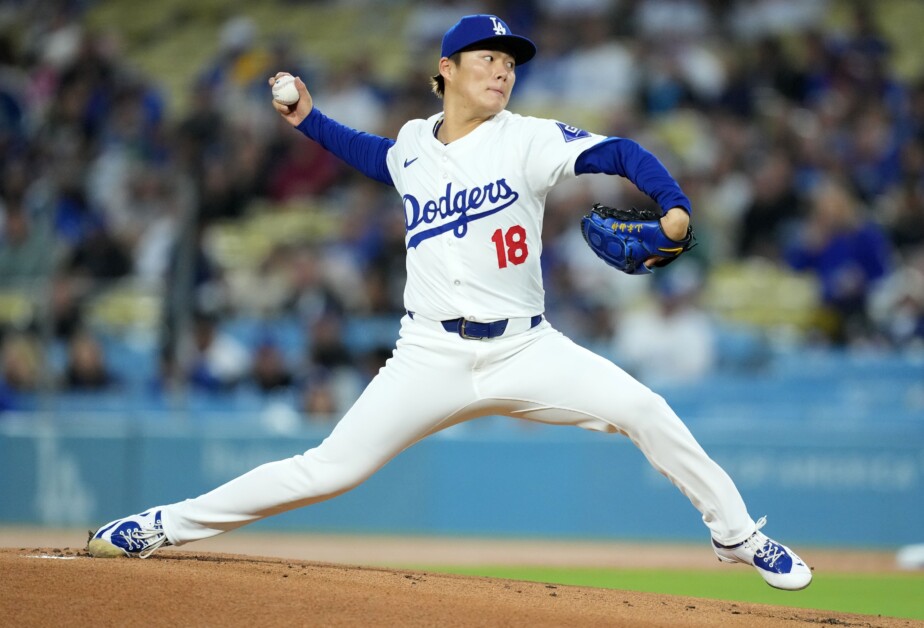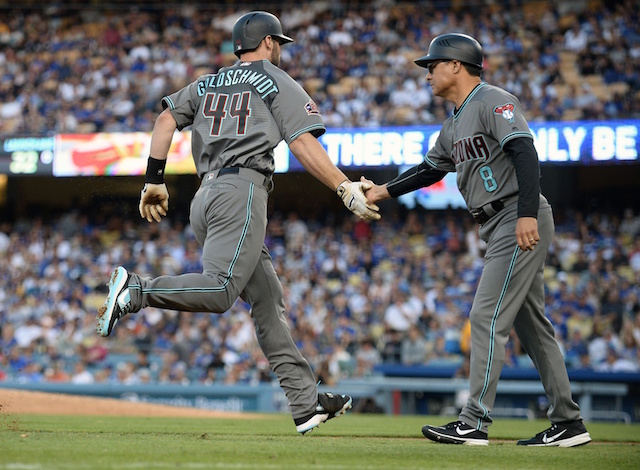I remember one of the first times I ever sat down at a blackjack table — sitting with my dad to learn the ins and outs. I quickly learned that blackjack was all about playing the odds — there was not just one factor to consider when deciding whether to hit or stay.
My cards mattered, of course, but so did whatever information I had about the dealer’s hand. You see, the goal of blackjack is not so much to win as it is to put yourself in the best situation to win.
If you play with bad strategy you might win every once in a while, but in the long run it’ll cost you.
For some reason, when I watched Dave Roberts manage the Los Angeles Dodgers in Game 5 of the National League Division Series, I couldn’t get blackjack out of my mind.
Why? Because as I tried to fall asleep Wednesday night I couldn’t help but think: the manager’s one job is to put his guys in the best position to win, and he unequivocally failed to do that.
The reality is that Roberts made a thousand decisions in Game 5 — maybe more when you include the run-up to the night itself. Who to start, where to play them, where to bat them, where to position them, etc.
The truth is, Roberts probably made hundreds of right decisions in regards to the winner-take-all matchup with the Washington Nationals.
Unfortunately, a small handful of those were so bad that the other 900+ don’t matter. They can’t matter. They’ll never matter.
These decisions were so indefensible that hearing Roberts try to justify them postgame offered more pain than it did closure — which is too bad considering how much he has contributed thus far in four seasons as a manager.
The truth is, the other 696 games Roberts has managed will be forgotten, because on Wednesday night he left two pitchers — Clayton Kershaw and Joe Kelly — in far too long.
Decision 1: Bringing Clayton Kershaw into the game
The scene: it’s the seventh inning and there are runners at first and second base with two outs, and left-handed hitting Adam Eaton coming to the plate. With Walker Buehler at 117 pitches, Roberts came to the mound to get him while summoning Kershaw to be his first reliever of the game.
On three pitches, Kershaw got Eaton to strike out, ending the threat. Crisis averted.
But let me pause here, because I think something needs to be said: just because Kershaw got the strikeout doesn’t mean this was the right decision. If you’re playing blackjack and you’ve got 14 while the dealer is showing a six, the smart move is not to hit, but to stay.
Could you hit and still win? Sure, but the odds aren’t in your favor.
Roberts bringing Kershaw into the game as his first reliever (in a game in which he only needed seven outs from his bullpen) was the equivalent of hitting on 14. Why? You only needed seven outs and you had a fully rested bullpen.
Then again, I could at least see the logic of this move and so we’ll gladly accept a risky decision and move forward.
Decision 2: Letting Clayton Kershaw pitch to Anthony Rendon
After the Dodgers went 1-2-3 in the bottom of the seventh, the Nationals brought the heart of their lineup to the plate in the form of Anthony Rendon and Juan Soto. So what does Roberts do with just six outs between his team and the NL Championship Series?
He leaves Kershaw in the game. The thinking is predictable: Kershaw needed just three pitches to dispatch of Adam Eaton, he’s the face of the franchise, he’s been in big spots before, etc.
However, while that may have been what Roberts was thinking doesn’t mean that any of it was what he should have been thinking.
The thing I’ll never understand is why everyone assumes that Kershaw is an elite reliever. He is a really, really good starting pitcher still, sure, but reliever? In his regular season career, Kershaw has thrown four innings of relief — three of which came in 2008 and 2009.
In his postseason career, he has made seven relief appearances — with just four of those appearances (six innings total) having come since 2009.
The argument for Kershaw is that in his previous three postseason relief appearances, he has allowed zero runs. However let’s not forget that: a) we’re talking about an absurdly small sample size, and b) Clayton Kershaw in 2017 is different than Clayton Kershaw in 2019.
And yet, there was Kershaw — having gotten the biggest out of the game, having had to sit in the dugout while the Dodgers hit — going back out for the eighth to face the best hitter the other team has.
Anthony Rendon is a bonafide MVP candidate — and one who hits lefties even better than righties. His splits this season against left-handed-pitching: .316/.433/.618. So why did the Dodgers have a lefty throwing to him when they had Kenta Maeda, Joe Kelly, Kenley Jansen and Pedro Baez all available? Who knows.
Result: solo home run, lead cut to 3-2.
Decision 3: Letting Clayton Kershaw pitch to Juan Soto
Have I mentioned yet that the Dodgers had a fully rested bullpen?
Included in that group was Adam Kolarek. The lefty specialist who had faced Soto three times so far, making easy work of him every single time.
Why bring in the lefty specialist to face a lefty when you can leave a starting-turned-relief pitcher who has give given up a home run? Great question.
Result: solo home run, game is tied at 3-3.
With seven outs to go, a fully stocked bullpen and two-run lead all in the rearview, the Dodgers now enter the bottom of the eighth inning (after Maeda continued to absolutely dominate) tied.
Decision 4: Bringing Joe Kelly back out for the 10th inning
You might be surprised to see me actually somewhat in favor of this decision, but first let us catch up in the game. After Maeda made quick work of the Nationals in the eighth and the Dodgers went down in order in the bottom half of the inning, Kelly got the ball for the Dodgers.
In just 10 pitches he dispatched the bottom of the order (plus Trea Turner) without allowing a baserunner.
So, after the Dodgers couldn’t end the game in the bottom of the ninth, Roberts had a decision to make about what to do in the 10th. As a reminder, here are the relievers still available to him: Kenley Jansen, Pedro Baez, Dustin May, Adam Kolarek, Julio Urias and Ross Stripling.
Due up for the Nationals in the 10th: Eaton, Rendon, Soto and Howie Kendrick.
The decision to leave Kelly in here was actually defensible. He looked good and (very much in theory) he’s one of your top two relief pitchers. If you’re looking at an extra-innings game, getting a couple extra outs from Kelly would have been ideal.
However, when he walked Adam Eaton to start the inning, everything changes…
Decision 5: Letting Joe Kelly pitch to Anthony Rendon
Have we seen this movie before? It appears we have. Why bother summoning Jansen — the closer you insisted was fine all season and who actually looked good in his one appearance in this series?
Or Baez, who held right-handed hitters to a slash line of .172/.274/.281? Or May or literally anyone other than the pitcher who just walked the leadoff man in a tie game that involves the loser going home?
Result: ground-rule double that puts runners at second and third base with nobody out.
Decision 6: Intentionally walking Juan Soto
Some folks will argue this is where Kolarek should have been summoned, rather than putting an extra runner on base. I see the thinking, but I also don’t have much of an issue with loading the bases so that you can get a force out at home.
Not saying it’s the right move, but again — relative to what’s about to happen next, this seems like it was made by a Harvard-educated mathematician.
Decision 7: Letting Joe Kelly face Howie Kendrick
What the heck are we doing? The last time Kelly got more than three outs was Aug 24. And yet here he is facing his seventh batter in a winner-take-all elimination game. Did I mention that the Dodgers had options in the bullpen?
I complained all season about Roberts not having the gumption to pull Jansen from the closer role, but if you’re going to roll with him all season why decide that this was the spot that you would cease to think he was the team’s best reliever?
Again: literally anything other than “leave Joe Kelly in” is the right move here. Literally anything.
Result: grand slam, Dodgers trail 7-3
Decisions 8, 9: Letting Joe Kelly face Ryan Zimmerman and Ryan Gomes
This is a fireable offense, honestly. I like Roberts and I don’t think firing him for one game (even this one) is automatic, but these two calls are absolutely indefensible.
Does this game feel over at this point? Of course. Is it? Absolutely not. So why leave the pitcher who has just given up four runs in his second inning of work without recording an out, in? The only answer I can think of is laziness or apathy. It’s honestly mind-blowing.
Result: out, single (then Jansen comes in and gets two quick outs to end the inning)
It’s easier to stomach a loss when you realize you didn’t deserve to win or when it wasn’t really close. But when there’s room to blame a manager or an umpire or whatever, it hurts significantly more.
On Wednesday night, Dave Roberts failed his players and the fans. Simply put.
It’s going to be hard to forget.










